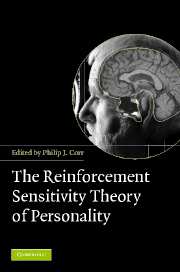Book contents
- Frontmatter
- Contents
- List of abbreviations
- List of figures
- List of tables
- List of contributors
- Preface
- 1 Reinforcement Sensitivity Theory (RST): introduction
- 2 The neuropsychology of fear and anxiety: a foundation for Reinforcement Sensitivity Theory
- 3 Animal cognition and human personality
- 4 The behavioural activation system: challenges and opportunities
- 5 Reinforcement Sensitivity Theory and personality
- 6 Reinforcement sensitivity scales
- 7 Performance and conditioning studies
- 8 Psychophysiological studies
- 9 Reinforcement Sensitivity Theory and mood induction studies
- 10 Neuro-imaging and genetics
- 11 Reinforcement Sensitivity Theory and psychosomatic medicine
- 12 RST and clinical disorders: anxiety and depression
- 13 RST and psychopathy: associations between psychopathy and the behavioral activation and inhibition systems
- 14 Behavioural activation and inhibition in social adjustment
- 15 Reinforcement sensitivity in the workplace: BIS/BAS in business
- 16 Formal and computational models of Reinforcement Sensitivity Theory
- 17 Reinforcement Sensitivity Theory: a critique from cognitive science
- 18 The contribution of Reinforcement Sensitivity Theory to personality theory
- General Index
- Index of Names
- References
7 - Performance and conditioning studies
Published online by Cambridge University Press: 31 January 2011
- Frontmatter
- Contents
- List of abbreviations
- List of figures
- List of tables
- List of contributors
- Preface
- 1 Reinforcement Sensitivity Theory (RST): introduction
- 2 The neuropsychology of fear and anxiety: a foundation for Reinforcement Sensitivity Theory
- 3 Animal cognition and human personality
- 4 The behavioural activation system: challenges and opportunities
- 5 Reinforcement Sensitivity Theory and personality
- 6 Reinforcement sensitivity scales
- 7 Performance and conditioning studies
- 8 Psychophysiological studies
- 9 Reinforcement Sensitivity Theory and mood induction studies
- 10 Neuro-imaging and genetics
- 11 Reinforcement Sensitivity Theory and psychosomatic medicine
- 12 RST and clinical disorders: anxiety and depression
- 13 RST and psychopathy: associations between psychopathy and the behavioral activation and inhibition systems
- 14 Behavioural activation and inhibition in social adjustment
- 15 Reinforcement sensitivity in the workplace: BIS/BAS in business
- 16 Formal and computational models of Reinforcement Sensitivity Theory
- 17 Reinforcement Sensitivity Theory: a critique from cognitive science
- 18 The contribution of Reinforcement Sensitivity Theory to personality theory
- General Index
- Index of Names
- References
Summary
Since 1970, J. A. Gray (1970, 1981, 1982, 1987a) has outlined several aspects of a personality model called Reinforcement Sensitivity Theory (RST). This model has generated a great amount of experimental research and has been applied to adult psychopathology (Fowles 1988), psychophysiology (Fowles 1980), child psychopathology (Quay 1988; Nigg 2000, 2001) and disinhibited behaviour (Patterson and Newman 1993). The impression one has thirty years on, however, is that the model still has some grey areas since it was first proposed, which are lacking in detail and in some ways limit its development (see Pickering, Corr, Powell, Kumari, Thornton and Gray 1997).
Theoretical contributions and controversial issues of RST
Considering basically performance and conditioning studies, the aim of the present chapter is to raise some of the model's problematic aspects and to put forward some hypotheses and practical issues in regard to its application to humans. The chapter begins by setting out Gray's model in its initial formulation, and further theoretical contributions (Corr 2002, 2004; Patterson and Newman 1993; Wallace and Newman 1990). We shall then deal with aspects which we consider essential with regard to application to humans, and compile the results of the research work in this field from a new point of view. Owing to the fact that measures of BIS and BAS are based on Gray's classical model (Gray 1982), and that it remains to be seen how the new model by Gray and McNaughton (2000) fits in, the basis of this review will be the classical RST model.
Information
- Type
- Chapter
- Information
- The Reinforcement Sensitivity Theory of Personality , pp. 228 - 260Publisher: Cambridge University PressPrint publication year: 2008
References
Accessibility standard: Unknown
- 10
- Cited by
